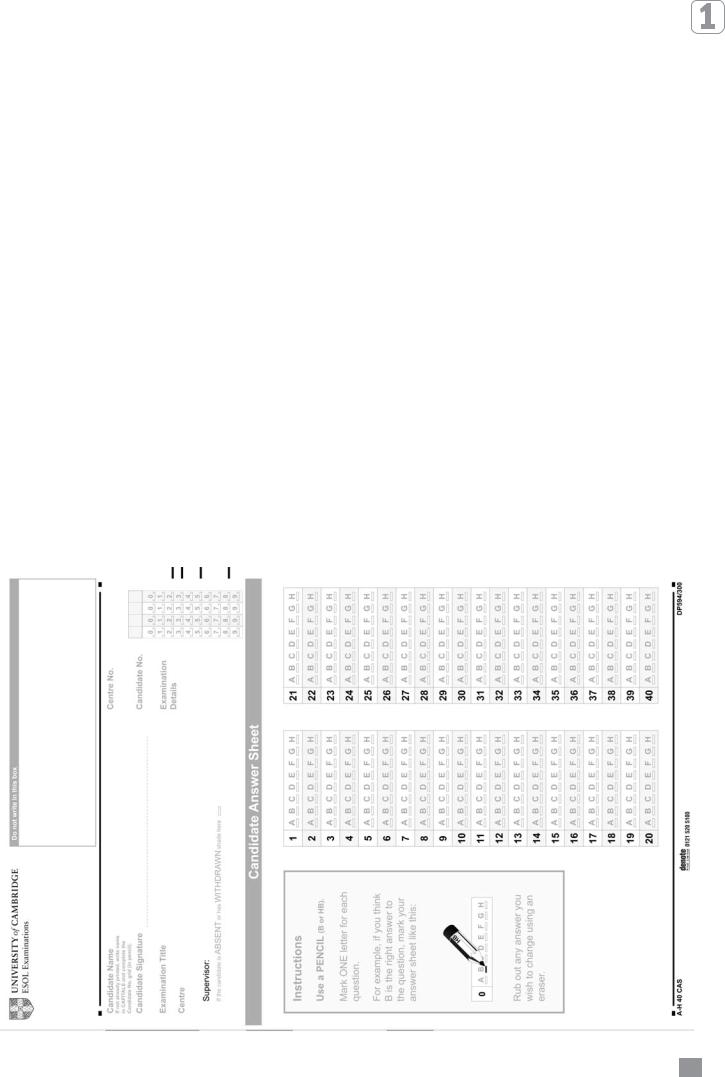
fce_handbook
.pdf
hobbies and interests by reading magazines about sport, cars, fashion, etc. in English. If relevant magazines are not available locally, you may be able to access them on the internet.
Reading up about hobbies etc. could also lead to written articles for a class project, or short talks.
■Make sure your students are familiar with the format of the Reading paper. Train them to read carefully the instructions on the front page of the question paper and at the start of each task. The instructions give a brief context for each text and remind candidates what they have to do.
■Show your students how to fill in the answer sheet and give them practice in doing this in a timed exercise. Explain to them that they can transfer their answers after each task or at the end of the paper.
■When your students are familiar with the different task types, discuss with them which part(s) take them longer to complete. Following this discussion, you could work out with them possible timings for each task. Remind them that each task is worth approximately equal marks. The outcome of the discussion will also help you to decide which task types to concentrate on in future classes and where assistance is needed with developing particular reading skills.
By part
■PART 1
■Train your students to read through the text before looking at the questions. As three out of the four options are incorrect, there is no point in trying to absorb them all before tackling the text.
■Get your students to read each stem carefully so that they have some idea of what they need to look for.
■Warn your students about the risks of ‘word spotting’, that is assuming that an option must be correct simply because it contains a word that is also in the text. Students need to check that the meaning of an option is reflected in the text, not that one word is the same in both.
■When the questions take the form of incomplete sentences, encourage your students to read both parts of the sentence carefully. They need to check that the whole sentence matches what is written in the text and not just the phrase in option A, B, C or D.
■Make sure your students read texts in which opinions, ideas and attitudes are expressed, such as interviews with well-known people in which they explain how they started out in their field and what they believe helped them to be successful, or extracts from novels which focus on characters’ feelings.
■PART 2
■Train your students to read through the text with the gaps in it so that they gain an overall idea of the structure of the text and the development of the writer’s ideas, before starting to do the task.
■When your students are selecting a sentence to fill a gap, make sure that they look carefully at the information before and after the gap. Candidates sometimes make the wrong choices by selecting options which seem to fit the text before the gap, and neglecting to check that the text after the gap follows on logically.
■Give your students plenty of practice in recognising a wide range of linguistic devices which mark the logical and cohesive development of a text, for example words and phrases indicating time periods, cause and effect, exemplification, contrasting arguments, repetition, concordance of tenses, pronouns, etc. This will help them to make the correct choice between two possible sentences which seem rather similar at first sight.
■As in Part 1, it is important to discourage your students from relying on ‘word spotting’, that is assuming that if the same word, name, date, etc. appears in the surrounding text and one of the options, that is automatically the right sentence to fill the gap. Train them to check all the other linguistic clues carefully before making their final decision.
■PART 3
■Your students will need practice in skimming and scanning texts quickly for specific information in order to prepare for this task. Once they have had this, it may be helpful to divide the class into teams and encourage them to ‘race’ against each other. Points should be deducted for incorrect answers, to emphasise the need for accuracy as well as speed.
■In class, ask your students to tell you why a particular part of the text matches a prompt. This will help them to check their choices carefully. Once again, discourage them from choosing an answer on the basis of similar vocabulary alone.
■Give your students plenty of opportunity to read book and film reviews or articles in which a number of different people express their thoughts about their career, hobbies, etc. You could also ask students, either as a pair or group activity in class or as a homework assignment, to devise their own Part 3 task, based on texts you provide or ones that they find for themselves. Writing challenging questions for their classmates to try will help the students understand what clues they will need to look for when tackling a real Part 3 task.
f c e h a n d b o o k f o r t e a c h e r s | pa pe r 1 : r e a d i n g |
9 |
|
|

1 st te – r pe pa e l p m sa | g n i d a e r : 1 r pe pa | s r e h c a e t r o f k o o b d n a h e c f 10
Part 1
You are going to read an extract from a novel. For questions 1 – 8, choose the answer (A, B, C or D) which you think fits best according to the text.
Mark your answers on the separate answer sheet.
I shifted uncomfortably inside my best suit and eased a finger inside the tight white collar. It was hot in the little bus and I had taken a seat on the wrong side where the summer sun beat on the windows. It was a strange outfit for the weather, but a few miles ahead my future employer might be waiting for me and I had to make a good impression.
There was a lot depending on this interview. Many friends who had qualified with me were unemployed or working in shops or as labourers in the shipyards. So many that I had almost given up hope of any future for myself as a veterinary surgeon.
There were usually two or three jobs advertised in the Veterinary Record each week and an average of eighty applicants for each one. It hadn’t seemed possible when the letter came from Darrowby in Yorkshire. Mr S. Farnon would like to see me on the Friday afternoon; I was to come to tea and, if we were suited to each other, I could stay on as his assistant. Most young people emerging from the colleges after five years of hard work were faced by a world unimpressed by their enthusiasm and bursting
line 15 knowledge. So I had grabbed the lifeline unbelievingly.
The driver crashed his gears again as we went into another steep bend. We had been climbing steadily now for the last fifteen miles or so, moving closer to the distant blue of the Pennine Hills. I had never been in Yorkshire before, but the name had always raised a picture of a region as heavy and unromantic as the pudding of the same name; I was prepared for solid respectability, dullness and a total lack of charm. But as the bus made its way higher, I began to wonder. There were high grassy hills and wide valleys. In the valley bottoms, rivers twisted among the trees and solid grey stone farmhouses lay among islands of cultivated land which pushed up the wild, dark hillsides.
Suddenly, I realised the bus was clattering along a narrow street which opened onto a square where we stopped. Above the window of a small grocer’s shop I read ‘Darrowby Co-operative Society’. We had arrived. I got out and stood beside my battered suitcase, looking about me. There was something unusual and I didn’t know what it was at first. Then it came to me. The other passengers had dispersed, the driver had switched off the engine and there was not a sound or a movement anywhere. The only visible sign of life was a group of old men sitting round the clock tower in the centre of the square, but they might have been carved of stone.
Darrowby didn’t get much space in the guidebooks, but where it was mentioned it was described as a grey little town on the River Arrow with a market place and little of interest except its two ancient bridges. But when you looked at it, its setting was beautiful. Everywhere from the windows of houses in Darrowby you could see the hills. There was a clearness in the air, a sense of space and airiness that made me feel I had left something behind. The pressure of the city, the noise, the smoke – already they seemed to be falling away from me.
Trengate Street was a quiet road leading off the square and from there I had my first sight of Skeldale House. I knew it was the right place before I was near enough to read S. Farnon, Veterinary Surgeon on the old-fashioned brass nameplate. I knew by the ivy which grew untidily over the red brick, climbing up to the topmost windows. It was what the letter had said – the only house with ivy; and this could be where I would work for the first time as a veterinary surgeon. I rang the doorbell.
1As he travelled, the writer regretted his choice of
Aseat.
Bclothes.
Ccareer.
Dmeans of transport.
2What had surprised the writer about the job?
A There had been no advertisement.
B He had been contacted by letter.
CThere was an invitation to tea.
DHe had been selected for interview.
3The writer uses the phrase ‘I had grabbed the lifeline’ (line 15) to show that he felt
A confident of his ability.
B ready to consider any offer.
C cautious about accepting the invitation. D forced to make a decision unwillingly.
4What impression had the writer previously had of Yorkshire?
A It was a beautiful place. B It was a boring place.
C It was a charming place. D It was an unhappy place.
5What did the writer find unusual about Darrowby?
A the location of the bus stop B the small number of shops C the design of the square
D the lack of activity
6What did the writer feel the guidebooks had missed about Darrowby?
Athe beauty of the houses
B the importance of the bridges
C the lovely views from the town
Dthe impressive public spaces
7How did the writer recognise Skeldale House?
A The name was on the door. B It had red bricks.
C There was a certain plant outside. D It stood alone.
8How did the writer’s attitude change during the passage?
A He began to feel he might like living in Darrowby. B He became less enthusiastic about the job.
C He realised his journey was likely to have been a waste of time. D He started to look forward to having the interview.
Turn Over Ź
(questions 1 Part 1 Test |
READING 1: PAPER |
8)–1 |
|

11 1 st te – r pe pa e l p m sa | g n i d a e r : 1 r pe pa | s r e h c a e t r o f k o o b d n a h e c f
Part 2
You are going to read an article about a woman who is a downhill mountain-bike racer. Seven sentences have been removed from the article. Choose from the sentences A – H the one which fits each gap (9 – 15). There is one extra sentence which you do not need to use.
Mark your answers on the separate answer sheet.
Downhill racer
Anna Jones tells of her move from skiing to downhill mountain biking and her rapid rise up the ranks to her current position as one of the top five downhill racers in the country.
At the age of seven I had learnt to ski and
by fourteen I was competing internationally. When I was eighteen a close friend was injured
in a ski race, and as a result, I gave up
competitive skiing. To fill the gap that skiing had left I decided to swap two planks of wood for two wheels with big tyres.
My first race was a cross-country race in 1995.
It wasn’t an amazing success. |
9 |
|
After |
entering a few more cross-country races, a local bike shop gave me a downhill bike to try. I entered a downhill race, fell off, but did reasonably well in the end, so I switched to downhill racing.
I think my skiing helped a lot as I was able to transfer several skills such as cornering and weight-balance to mountain biking. This year I’m riding for a famous British team and there are races almost every weekend from March through
to September. |
10 |
|
In fact, there’s quite a |
lot of putting up tents in muddy fields.
Last season I was selected to represent Great Britain at both the European and World Championships. Both events were completely different from the UK race scene. 11 
 I was totally in awe, racing with the riders I had been following in magazines. The atmosphere was electric and I finished about mid-pack.
I was totally in awe, racing with the riders I had been following in magazines. The atmosphere was electric and I finished about mid-pack.
Mountain biking is a great sport to be in. People ask me if downhill racing is really scary. I say, ‘Yes it is, and I love it.’ Every time I race I scare myself silly and then say, ‘Yeah let’s do it again.’
When you’re riding well, you are right on the edge, as close as you can be to being out of
control. |
12 |
|
However, you quickly learn |
how to do it so as not to injure yourself. And it’s part of the learning process as you have to push yourself and try new skills to improve.
Initially, downhill racing wasn’t taken seriously as a mountain-biking discipline. 13 
 But things are changing and riders are now realising that they need to train just as hard for downhill racing as they would do for cross-country.
But things are changing and riders are now realising that they need to train just as hard for downhill racing as they would do for cross-country.
The races are run over ground which is generally closer to vertical than horizontal, with jumps, drop-offs, holes, corners and nasty rocks and trees to test your nerves as well as technical skill. At the end of a run, which is between two and three minutes in this country your legs hurt
so much they burn. |
14 |
|
But in a race, |
you’re so excited that you switch off to the pain until you’ve finished.
A lot of people think that you need to spend thousands of pounds to give downhill mountain
biking a go. |
15 |
|
A reasonable beginner’s |
downhill bike will cost you around £400 and the basic equipment, of a cycle helmet, cycle shorts and gloves, around £150. Later on you may want to upgrade your bike and get a full-face crash helmet, since riders are now achieving speeds of up to 80 kilometres per hour.
AI’ve fallen off more times than I care to remember.
BI usually have to stop during practice sessions.
CThe courses were twice as long and the crowds were twice as big.
DI’m not strong enough in my arms, so I’ve been doing a lot of upper-body training this year.
EThe attitude was: how much skill do you need to sit on a saddle and point a bike in the same direction for a few minutes?
FI finished last, but it didn’t matter as I really enjoyed it.
GNothing could be further from the truth.
HIt’s not all stardom and glamour, though.
Turn Over Ź
READING 1: PAPER
15)–9 (questions 2 Part 1 Test

1 st te – r pe pa e l p m sa | g n i d a e r : 1 r pe pa | s r e h c a e t r o f k o o b d n a h e c f 12
Part 3
You are going to read a magazine article about people who collect things. For questions 16 – 30, choose from the people (A – D). The people may be chosen more than once.
Mark your answers on the separate answer sheet.
Which person
had to re-start their collection? |
16 |
|
|
|
|
has provided useful advice on their subject? |
17 |
|
|
|
|
was misled by an early success? |
18 |
|
|
|
|
received an unexpected gift? |
19 |
|
|
|
|
admits to making little practical use of their collection? |
20 |
|
|
|
|
regrets the rapid disappearance of certain items? |
21 |
|
|
|
|
is aware that a fuller collection of items exists elsewhere? |
22 |
|
|
|
|
has a history of collecting different items? |
23 |
|
|
|
|
performed a favour for someone they knew? |
24 |
|
|
|
|
is a national expert on their subject? |
25 |
|
|
|
|
is aware that they form part of a growing group? |
26 |
|
|
|
|
insists on purchasing top-quality items? |
27 |
|
|
|
|
noticed items while looking for something else? |
28 |
|
|
|
|
has to protect their collection from damage? |
29 |
|
|
|
|
would like to create a hands-on display of their collection? |
30 |
|
|
|
|
The World of Collecting
ARon Barton shares his home with about 200 sewing machines. His passion began when he was searching for bits of second-hand furniture and kept seeing ‘beautiful old sewing machines that were next to nothing to buy’. He couldn’t resist them. Then a friend had a machine that wouldn’t work, so she asked Barton to look at it for her. At that stage he was not an authority on the subject, but he worked on it for three days and eventually got it going.
Later he opened up a small stand in a London market. ‘Most people seemed uninterested. Then a dealer came and bought everything I’d taken along. I thought, “Great! This is my future life.” But after that I never sold another one there and ended up with a stall in another market which was only moderately successful.’
Nowadays, he concentrates on domestic machines in their original box containers with their handbooks. He is often asked if he does any sewing with them. The answer is that, apart from making sure that they work, he rarely touches them.
BAs a boy, Chris Peters collected hundreds of vintage cameras, mostly from jumble sales and dustbins. Later, when the time came to buy his first house, he had to sell his valuable collection in order to put down a deposit. A few years after, he took up the interest again and now has over a thousand cameras, the earliest dating from 1860.
Now Peters ‘just cannot stop collecting’ and hopes to open his own photographic museum where members of the public will be able to touch and fiddle around with the cameras. Whilst acknowledging that the Royal Camera Collection in Bath is probably more extensive than his own, he points out that ‘so few of the items are on show there at the same time that I think my own personal collection will easily rival it.’
CSylvia King is one of the foremost authorities on plastics in Britain. She has, in every corner of her house, a striking collection of plastic objects of every kind, dating from the middle of the last century and illustrating the complex uses of plastic over the years.
King’s interest started when she was commissioned to write her first book. In order to do this, she had to start from scratch; so she attended a course on work machinery, maintaining that if she didn’t understand plastics manufacture then nobody else would.
As she gathered information for her book, she also began to collect pieces of plastic from every imaginable source: junk shops, arcades, and the cupboards of friends. She also collects ‘because it is vital to keep examples. We live in an age of throw-away items: taperecorders, cassettes, hair dryers – they are all replaced so quickly.’
King’s second book, Classic Plastics: from Bakelite to High Tech, is the first published guide to plastics collecting. It describes collections that can be visited and gives simple and safe home tests for identification.
King admits that ‘plastic is a mysterious substance and many people are frightened of it. Even so, the band of collectors is constantly expanding.’
DJanet Pontin already had twenty years of collecting one thing or another behind her when she started collecting ‘art deco’ fans in 1966. It happened when she went to an auction sale and saw a shoe-box filled with them. Someone else got them by offering a higher price and she was very cross. Later, to her astonishment, he went round to her flat and presented them to her. ‘That was how it all started.’ There were about five fans in the shoe-box and since then they’ve been exhibited in the first really big exhibition of ‘art deco’ in America. The fans are not normally on show, however, but are kept behind glass. They are extremely fragile and people are tempted to handle them. The idea is to have, one day, a black-lacquered room where they can be more easily seen.
Pontin doesn’t restrict herself to fans of a particular period, but she will only buy a fan if it is in excellent condition. The same rule applies to everything in her house.
(questions 3 Part 1 Test |
READING 1: PAPER |
30)–16 |
|

PAPER 1: READING
Answer keys
Test 1
PART ONE |
PART TWO |
PART THREE |
|||||
|
|
|
|
|
|
|
|
1 |
A |
9 |
F |
16 |
B |
||
2 |
D |
10 |
H |
17 |
C |
||
3 |
B |
11 |
C |
18 |
A |
||
4 |
B |
12 |
A |
19 |
D |
||
5 |
D |
13 |
E |
20 |
A |
||
6 |
C |
14 |
B |
21 |
C |
||
7 |
C |
15 |
G |
22 |
B |
||
8 |
A |
|
|
|
23 |
D |
|
|
|
|
|
|
24 |
A |
|
|
|
|
|
|
25 |
C |
|
|
|
|
|
|
26 |
C |
|
|
|
|
|
|
27 |
D |
|
|
|
|
|
|
28 |
A |
|
|
|
|
|
|
29 |
D |
|
|
|
|
|
|
30 |
B |
|
f c e h a n d b o o k f o r t e a c h e r s | pa pe r 1 : r e a d i n g | a ns we r k e ys f o r te st 1 |
13 |
|
|

2 st te – r pe pa e l p m sa | g n i d a e r : 1 r pe pa | s r e h c a e t r o f k o o b d n a h e c f 14
Part 1
You are going to read a magazine article about a company called Holiday on Ice, which puts on iceskating shows. For questions 1 – 8, choose the answer (A, B, C or D) which you think fits best according to the text.
Mark your answers on the separate answer sheet.
_________________________________________________________________________________
Holiday on Ice
What is the secret of Holiday on Ice’s long-lasting success? Hilary Rose reports
At 7pm on a dark, cold November evening, thousands of people are making their way across a vast car park. They’re not here to see a film, or the ballet, or even the circus. They are all here for what is, bizarrely, a global phenomenon: they are here to see Holiday on Ice. Given that most people don’t seem to be acquainted with anyone who’s ever been, the show’s statistics are extraordinary: nearly 300 million people have seen Holiday on Ice since it began in 1943; it is the most popular live entertainment in the world.
But what does the production involve? And why are so many people prepared to spend their lives travelling round Europe in caravans in order to appear in it? It can’t be glamorous, and it’s undoubtedly hard work. The backstage atmosphere is an odd mix of gym class and workplace. A curtained-off section at the back of the arena is laughably referred to as the girls’ dressing room, but is more accurately described as a corridor, with beige, cracked walls and cheap temporary tables set up along the length of it. Each girl has a small area littered with pots of orange make-up, tubes of mascara and long false eyelashes.
As a place to work, it must rank pretty low down the scale: the area round the ice-rink is grey and mucky with rows of dirty blue and brown plastic seating and red carpet tiles. It’s an unimpressive picture, but the show itself is an unquestionably vast, polished global enterprise: the lights come from a firm in Texas, the people who make the audio system are in California, but Montreal supplies the smoke effects; former British Olympic skater Robin Cousins is now creative director for the company and conducts a vast master class to make sure they’re ready for the show’s next performance.
The next day, as the music blares out from the sound system, the cast start to go through their routines under Cousins’ direction. Cousins says, ‘The aim is to make sure they’re
all still getting to exactly the right place on the ice at the right time – largely because the banks of lights in the ceiling are set to those places, and if the skaters are all half a metre out they’ll be illuminating empty ice. Our challenge,’ he continues, ‘is to produce something they can sell in a number of countries at the same time. My theory is that you take those things that people want to see and you give it to them, but not in the way they expect to see it. You try to twist it. And you have to find music that is challenging to the skaters, because they have to do it every night.’
It may be a job which he took to pay the rent, but you can’t doubt his enthusiasm. ‘The only place you’ll see certain skating moves is an ice show,’ he says, ‘because you’re not allowed to do them in competition. It’s not in the rules. So the ice show world has things to offer which the competitive world just doesn’t.’ Cousins knows what he’s talking about because he skated for the show himself when he stopped competing – he was financially
unable to retire. He learnt the hard way that line 69 you can’t put on an Olympic performance every
night. ‘I’d be thinking, these people have paid their money, now do your stuff, and I suddenly thought, “I really can’t cope. I’m not enjoying it”.’ The solution, he realised, was to give 75 per cent every night, rather than striving for the sort of twice-a-year excellence which won him medals.
To be honest, for those of us whose only experience of ice-skating is watching top-class Olympic skaters, some of the movements can look a bit amateurish, but then, who are we to judge? Equally, it’s impossible not to be swept up in the whole thing; well, you’d have to try pretty hard not to enjoy it.
1What surprises the writer about the popularity of Holiday on Ice?
A The show has not changed since it started. B Few people know someone who has seen it. C Ice-skating is not generally a popular hobby.
D People often say they prefer other types of show.
2The writer describes the backstage area in order to show
A the conditions that the skaters put up with. B the type of skater that the show attracts.
C how much fun the cast have during their work.
D how much preparation is needed for a performance.
3What does the writer highlight about the show in the third paragraph?
A the need for a higher level of professional support B the difficulty of finding suitable equipment
C the range of companies involved in the production
D the variety of places in which the show has been staged
4For Robin Cousins, the key point when rehearsing skating routines is
A the movement of the lights.
B keeping in time with the music.
C filling all available space on the ice. D the skaters’ positions on the ice.
5Cousins believes that he can meet the challenge of producing shows for different audiences
Aby varying the routines each night.
Bby adapting movements to suit local tastes.
C by presenting familiar material in an unexpected way.
Dby selecting music that local audiences will respond to.
6What does Cousins suggest in paragraph 5 about skating in shows?
A It allows skaters to try out a range of ideas. B It enables skaters to visit a variety of places.
C It can be as competitive as other forms of skating. D It is particularly well paid.
7What is meant by ‘the hard way’ in line 69?
A through making a lot of errors
B through difficult personal experience C by over-estimating the ability of others
D by misunderstanding the expectations of others
8What conclusion does the writer draw about Holiday on Ice?
A It is more enjoyable to watch than formal ice-skating. B It requires as much skill as Olympic ice-skating.
C It is hard to know who really enjoys it. D It is difficult to dislike it.
Turn OverŹ
(questions 1 Part 2 Test |
READING 1: PAPER |
8)–1 |
|

15 2 st te – r pe pa e l p m sa | g n i d a e r : 1 r pe pa | s r e h c a e t r o f k o o b d n a h e c f
Part 2
You are going to read a newspaper article about a woman who spent last year as a judge for the British Theatre Awards. Seven sentences have been removed from the article. Choose from the sentences A – H the one which fits each gap (9 – 15). There is one extra sentence which you do not need to use.
Mark your answers on the separate answer sheet.
________________________________________________________________________________
Mrs Hart – amateur theatre critic
Who judges the British Theatre Awards? James Pickard finds out.
Elisabeth Hart went to the theatre in London 55 times last year. She read 55 programmes, saw 55 curtains rise and ate an undisclosed number of ice creams. On top of that, she had to write page after page of notes on each visit. However, she is not a professional theatre critic. She is an ordinary member of the public on the judging panel of this year’s British Theatre Awards.
Mrs Hart was one of four theatre-lovers chosen to judge all new drama productions (excluding
musicals) last year. |
9 |
|
Mrs Hart |
thinks this was a good system. ‘It’s important to have amateurs playing a part in the decisions,’ she says. ‘It stops the awards appearing to have been fixed like some others. And if a play wins an award, the public know that it’s been approved by people with no axe to grind.’
Mrs Hart is extremely enthusiastic about the theatre. ‘The year before last I went to over 30 plays,’ she says, ‘and they were a complete
mixed bag.’ |
10 |
|
It began with an |
application form left on a foyer shelf by the Society of London Theatre, which organises the awards. She filled it in, added a short theatre review, and was selected from several hundred applicants.
‘They were looking for people with a very wide taste in theatre,’ she explains. ‘I always enjoyed acting in plays when I was young, and as a
student in London, I regularly bought cheap standing tickets for West End productions.’ Being
a judge was hard work, though. 11
‘But I never got sick of it. Even the plays I didn’t like always had some redeeming qualities.’
She could never sit back and relax, though, because she had to make hefty notes on
everything. |
12 |
|
‘It wasn’t just the |
actors we were judging, but also costume design, direction, lighting and script – twelve categories in all. But I still enjoyed it. It felt like an enormous privilege.’
13 |
|
‘'That didn’t happen at all. It was |
all very civilised and friendly,’ says Mrs Hart. ‘We were listened to and our votes were all equal.’
Theatre critics, of course, are known for their
power to make or break a play. |
14 |
|
‘I wasn’t treated differently at all, although one receptionist did optimistically describe me as looking as if I was keen to enjoy my evening.’
|
15 |
|
|
‘It is bursting with talent on all |
fronts, from playwriting to direction, and there are plenty of innovative developments in productions. I personally think new writing should be encouraged. But overall, theatre is definitely alive and kicking.’
AHaving to take this approach meant that she couldn’t let her concentration slip at any time.
BIn this situation there is surely a danger of the professional critics dominating the discussions.
CRegular theatre-goers usually disagree with some of their judgements, of course, and Mrs Hart is no exception.
DThey were part of a panel that also included five professional theatre critics.
EHer appointment was therefore something of a dream come true for her.
FThe experience has left Mrs Hart optimistic about the state of British theatre.
GIn one week alone, her duties involved her reviewing as many as seven plays.
HSo did management show her enormous respect?
Turn OverŹ
READING 1: PAPER
15)–9 (questions 2 Part 2 Test

2 st te – r pe pa e l p m sa | g n i d a e r : 1 r pe pa | s r e h c a e t r o f k o o b d n a h e c f 16
Part 3
You are going to read an article in which four people describe their best teacher. For questions 16 – 30, choose from the people (A – D). The people may be chosen more than once.
Mark your answers on the separate answer sheet.
_________________________________________________________________________________
Which person had a teacher who
taught more than one member of the same family? |
16 |
|
|
|
|
might have preferred their pupil to choose a different career? |
17 |
|
|
|
|
was popular with all the pupils? |
18 |
|
|
|
|
had to overcome a disadvantage when teaching? |
19 |
|
|
|
|
made contact after their pupil left school? |
20 |
|
|
|
|
taught in an unusual physical position? |
21 |
|
|
|
|
changed their pupils’ behaviour? |
22 |
|
|
|
|
became their teacher as a result of a personal contact? |
23 |
|
|
|
|
developed their pupils’ physical and mental skills? |
24 |
|
|
|
|
pointed their pupil in the direction of a successful career? |
25 |
|
|
|
|
demonstrated a sense of humour? |
26 |
|
|
|
|
decided what to teach by responding to their pupil’s interests? |
27 |
|
|
|
|
showed what was necessary instead of talking about it? |
28 |
|
|
|
|
was also doing another job? |
29 |
|
|
|
|
put an emphasis on what pupils expressed, not the way they expressed it? |
30 |
|
|
|
|
My best teacher
AVeronique Tadjo
Tae Kwon Do is a martial art which has become popular as a sporting activity in recent years. I started learning it in the Ivory Coast in Africa when I was about 13, and later became the country’s first black belt. My teacher, Kim Young Tae, had been sent by the Tae Kwon Do federation in Korea to open a club. It was very successful. When he arrived he didn’t know a word of French so he used to demonstrate rather than explain. At the time my brother and I started learning Tae Kwon Do, we were fighting like mad. But we quickly understood we had to stop fighting because we realised that fighting was about self-defence, not aggression. Tae Kwon Do teaches you to control your anger and control your body. It is very good for your memory, co-ordination and self-discipline. And you are acquiring a philosophy. Later on, Kim opened a restaurant and then moved back to Korea. We had a very friendly relationship, but somehow I feel like I was a disappointment to him. He thought I had a future in the sport. But when I was 17 I decided it was not what I wanted to do.
BHelen Mirren
Everyone loved Miss Welding. She taught me between the ages of 13 and 17 and was instrumental in my becoming an actress. She knew I was interested in acting, but it just wasn’t an option in my world. My father was a driving examiner and I wasn’t exposed to acting as a career. It was Miss Welding who told me about the National Youth Theatre, which was an organisation I was unaware of. She suggested I look into it and think about going there. About ten years after I left school, when I was with the Royal Shakespeare Company and playing fairly high-profile parts, I got a letter from Miss Welding saying she was following my career with interest, but as far as I know, she never came to see me perform. She certainly never came to see me backstage.
CNisha Ishtiak
My father was editor of Pakistan’s largest newspaper and he knew and liked its librarian, Atif Burkhi. Atif was well-educated and when I was about 12 my father decided I should learn more about the region’s history and he chose Atif as my tutor. It turned out to be an inspired move. He would come to our house once a week to teach me, from the end of school until supper. He took me through a lot of history, but after a few lessons I got bored. ‘I know you’re being paid by my parents to teach me this stuff,’ I said, ‘but there are other things in the world.’ He burst out laughing as he so often did and asked: ‘What do you want to talk about then?’ And so we would discuss global issues and world literature.
DSuzanne Terry
Brian Earle, my English teacher was a very intense man with thick glasses, and the fact that he taught a lot of his classes standing on his head was also seen as extremely peculiar. He taught me for just one year and it was probably one of the most creative years of my life. He didn’t believe in giving marks for grammar or punctuation; he implied that the mechanics of writing were not important if you had something to say. When I wrote a short story for him called ‘Army’, he simply wrote across the bottom: 'You’ve just got to keep on writing.’ Those few words of support had a fantastic effect on me in terms of wanting to write and be involved in writing. Brian Earle had a love of teaching and his subject.
Turn OverŹ
(questions 3 Part 2 Test |
READING 1: PAPER |
30)–16 |
|

PAPER 1: READING
Answer keys and candidate answer sheet
Test 2
|
PART ONE |
PART TWO |
PART THREE |
|||||
|
|
|
|
|
|
|
|
|
1 |
B |
9 |
D |
16 |
A |
|||
2 |
A |
10 |
E |
17 |
A |
|||
3 |
C |
11 |
G |
18 |
B |
|||
4 |
D |
12 |
A |
19 |
A |
|||
5 |
C |
13 |
B |
20 |
B |
|||
6 |
A |
14 |
H |
21 |
D |
|||
7 |
B |
15 |
F |
22 |
A |
|||
8 |
D |
|
|
|
23 |
C |
||
|
|
|
|
|
|
24 |
A |
|
|
|
|
|
|
|
25 |
B |
|
|
|
|
|
|
|
26 |
C |
|
|
|
|
|
|
|
27 |
C |
|
|
|
|
|
|
|
28 |
A |
|
|
|
|
|
|
|
29 |
C |
|
|
|
|
|
|
|
30 |
D |
|
|
|
|
|
|
|
|
|
|
|
|
|
|
|
|
|
|
|
f c e h a n d b o o k f o r t e a c h e r s | pa pe r 1 : r e a d i n g | a ns we r k e ys f o r te st 2 a n d c a n d i date a ns we r sh e e t 17

PAPER 2
WRITING
GENERAL DESCRIPTION
Paper format |
The paper contains two parts. |
|
|
Timing |
1 hour 20 minutes. |
|
|
No. of parts |
2. |
|
|
No. of questions Candidates are required to complete two tasks:
a compulsory one in Part 1 and one from a choice of five in Part 2.
Task types |
From the following: |
|
an article, an email, an essay, |
|
a letter, a report, a review, |
|
a story. |
|
Each task has a given purpose |
|
and a target reader. |
|
|
Answer format |
The questions are in a booklet |
|
with lined pages for the |
|
answers. The blank pages |
|
at the back of the booklet |
|
can be used for writing |
|
notes or finishing answers, |
|
if necessary. |
|
|
Marks |
Each question on this paper |
|
carries equal marks. |
|
|
STRUCTURE AND TASKS
PART 1
Task type QUESTION 1
and focus Writing a letter or email.
Focus on advising, apologising, comparing, describing, explaining, expressing opinions, justifying, persuading, recommending and suggesting.
Format Candidates are required to deal with input material of up to 160 words. This may include material taken from advertisements, extracts from letters, emails, schedules, etc.
No. of tasks One compulsory task. and length 120–150 words.
PART 2
Task type QUESTIONS 2–4
and focus Writing one of the following: an article, an essay, a letter, a report, a review, a story.
QUESTION 5 (Question 5 has two options) Writing one of the following, based on one of two prescribed reading texts: an article, an essay, a letter, a report, a review.
Varying focuses according to the task, including: advising, comparing, describing, explaining, expressing opinions, justifying, recommending.
Format A situationally based writing task specified in no more than 70 words.
No. of tasks One task to be selected from a choice of five. and length 120–180 words.
18 |
f c e h a n d b o o k f o r t e a |
| pa pe r 2 : wr iti n g |
|
|
|
